|
The pre-war viewfinder Kodak Retinas were all of the folding type. They were introduced by Kodak at about the same time as it introduced the 135 film rolls that are still in use today. The combination was an instant success and the Kodak Retinas were some of the most popular 'miniature' cameras of that time.
Quite a few versions of the Kodak Retinas exist, as can be seen below. Kodak did not market these individually, but gradually replaced older versions with newer ones. These different versions did have different type numbers for internal Kodak use though, and those are the designations generally used for describing Kodak Retinas and are adopted here also.
This did not mean that production of a certain type was all the same, in fact more often than note small modifications were introduced during the lifetime of each type. In addition most models were available with different shutters and lenses. Finding all these variations is one of the fun things of collecting Kodak Retinas!
Kodak Retina 117
The first Kodak Retina model was introduced in the second half of 1934. It was a small, well-featured folding camera with a Compur or Compur-Rapid shutter, an excellent Xenar lens and a helical focus mount. It had two characteristic large wind and rewind knobs as well as a frame counter to the left of the viewfinder. A small knob between viewfinder and wind knob needed to be turned slightly to reset the wind lock mechanism after each exposure. To rewind the film at the end of the roll on needed to turn the dial inside the wind knob from A to R, which would release the clutch within the wind spool.
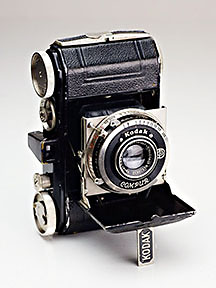
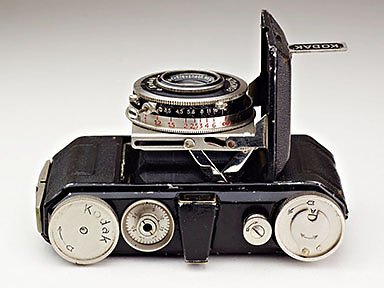
The first Kodak Retina model.
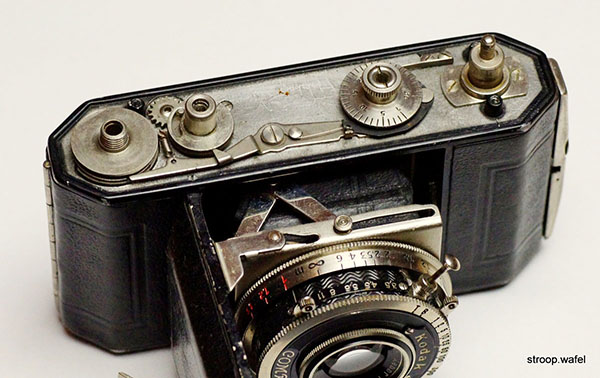
Kodak Retina 117 with top housing removed to show the wind lock and frame counter mechanism.
Kodak Retina 118
This second model was introduced shortly after the first. Like the 117, it had a completely black body and large distinct wind knobs. It differed from the 117 by having a small lever at the back to release the wind knob after each picture, which also operated the frame counter. This replaced the small knob next to the wind knob on the 117 with a similar function. The camera was available with either a Compur or Compur-Rapid shutter.
This model is most famous for being the camera that Sir Edmund Hilary took along when he climbed Mount Everest in 1953, with the iconic picture of Tensing waving the flags on the summit. By that time this was a pretty ancient camera, but clearly reliable enough! I am not sure how he managed to adjust the tiny controls wearing those big gloves, though. Coincidentally, Hilary's camera had a Carl Zeiss Tessar lens, which is a rare find nowadays.
Several changes occurred during production of the 118. Early production had polished metal door struts and a plain metal back door catch like the 117. Later production had black painted door struts and a grooved back door catch. The lettering on the rewind knob also changed.
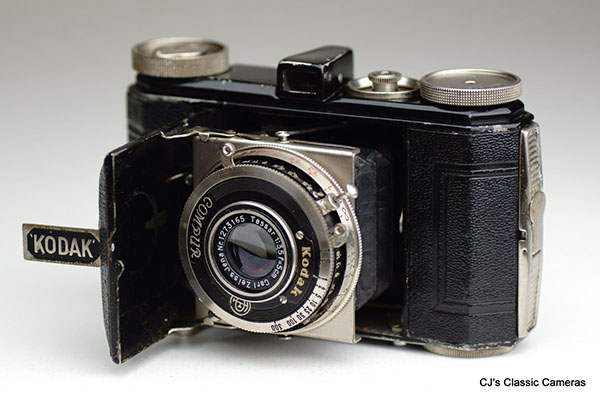
Kodak Retina 118 with rare Carl Zeiss Tessar 50mm f/3.5 lens in Compur shutter, similar to the camera Sir Edmund Hilary used (see above). This is an early production example with Ni-plated door struts.
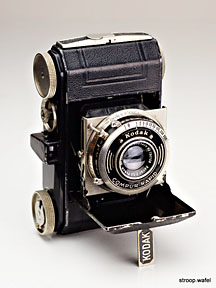
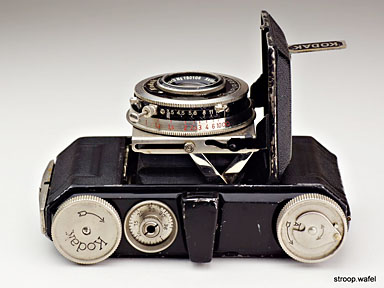
A late production Kodak Retina 118. Note the black painted door strut.
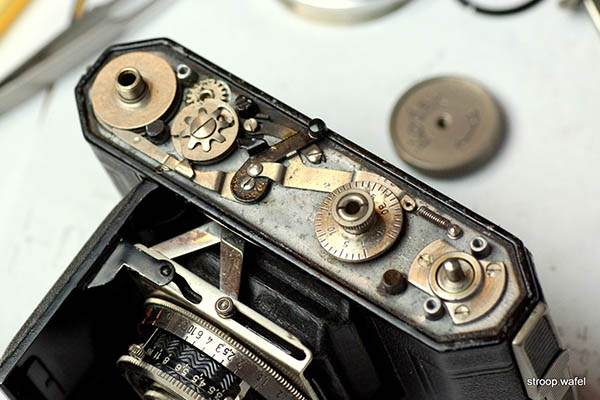
Kodak Retina 118 with top housing removed to show the wind lock and frame counter mechanism. The main difference with the Kodak Retina 117 above was the introduction of a small lever (visible in the top middle) instead of the small knob to reset the wind lock mechanism and advance the frame counter.
Kodak Retina 119
This was the third model, the last of the completely black bodies with the shutter release on the shutter housing itself. The frame counter moved next to the winding knob, and it stayed there for all following Kodak Retinas. The wind and rewind knob were also modified and stayed like that for many models to come. There appear to have been no changes during production of this model, but it was available with a choice of Xenar or Tessar lens and Compur or Compur-Rapid shutter.
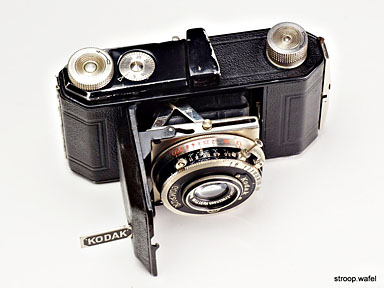
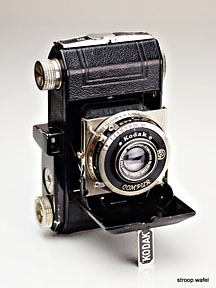
A Kodak Retina 119 with Schneider-Kreuznach Kodak Retina-Xenar 500mm f/3.5 lens in Compur shutter.
Kodak Retina 126
This is the last model with the shutter release is on the shutter housing itself. It was the first model with a plain metal
top housing, but otherwise nearly identical to the Kodak Retina 119. An accessory shoe could be fitted between the viewfinder and rewind knob.
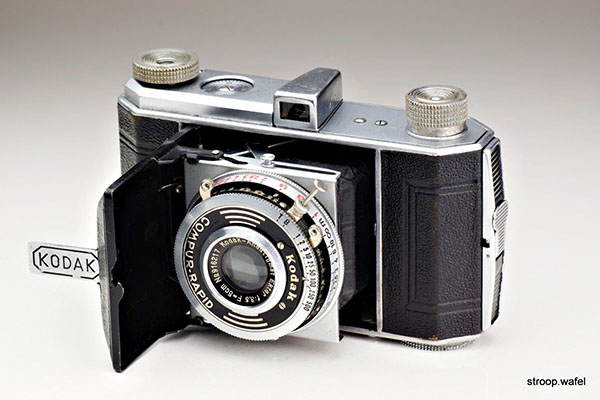
A Kodak Retina 126 with Kodak Anastigmat-Ektar 50mm f/3.5 lens in Compur-Rapid shutter.
Kodak Retina 141
This model was introduced in 1937 and was the first with a body shutter release. However, it still had the little lever at the back to reset the wind mechanism after each photo. The frame counter was quite distinctive on this model, and a rather strange diversion from earlier and later Kodak Retinas, which had quite similar looking frame counters.
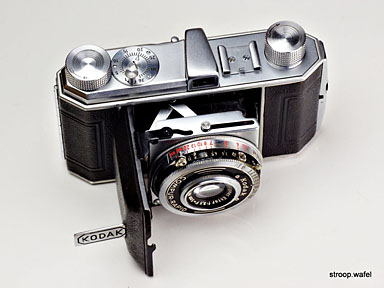
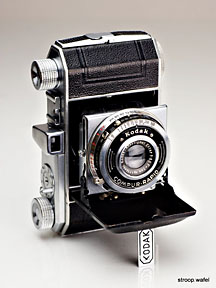
A Kodak Retina 141 with the same lens and shutter combination as the Type 126 above.
Kodak Retina 143
This was essentially the same model as the Kodak Retina 141 but with black enamel top housing and black leather inlay under the wind knob. In addition metal parts where nickel plated instead of chrome plated (recognisable by the slightly yellowish tint). Whereas the Kodak Retina 141 could be found with Anastigmat Ektar, Schneider Xenar or even Carl Zeiss Tessar lenses, the Kodak Retina 143 appears to have been available with a Schneider Xenar only.
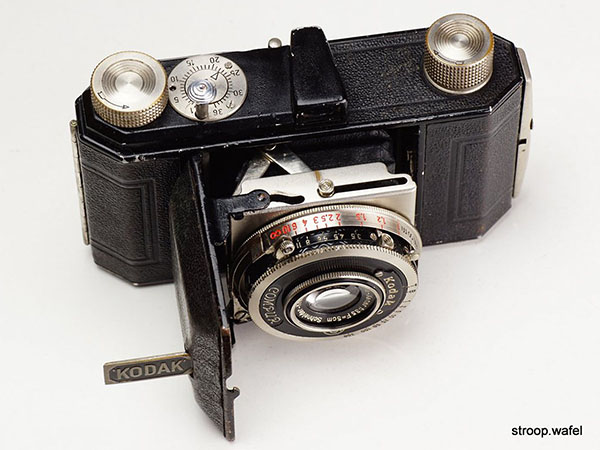
Kodak Retina 143 with Compur shutter and Schneider Xenar 50mm f/3.5.
Kodak Retina 148
This was the last pre-war model, together with the black trim 149, although production continued for some time during WWII itself. The styling is more similar to the 119 than the previous 143. One obvious difference with previous models was the shutter name, which was engraved in the speed ring instead of marked on the shutter plate, which itself changed from black enamel or paint to metal.
Quite a few small changes were made during production of this camera, the most obvious being the change from split to single-piece top housing, as can be seen on the examples below. Also the back door latch changed from a mushroom shape to rectangular, and late production had black lacquered body edges. These changes were not all introduced simultaneously, so at least 7 different body styles can be found. Add to this three different lenses and two different shutters, and one realises that one can probably spend a lifetime collecting just this model only!
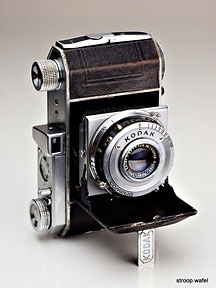
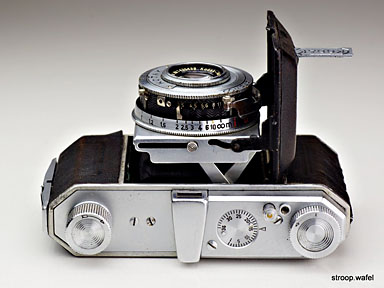
Early Kodak Retina 148 with split top housing and Kodak Anastigmat Ektar 50mm f/3.5 lens in Compur shutter..
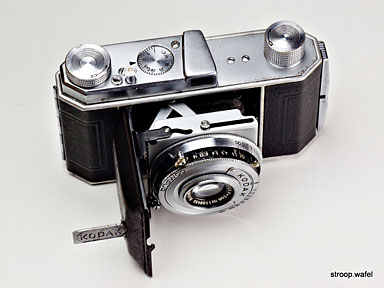
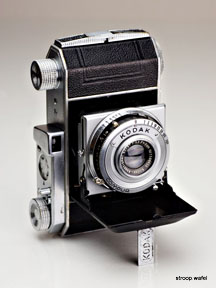
Late Kodak Retina 148 with one-piece top housing. Some other minor details differed from the earlier version, for example the frame number indicator is a filled black triangle instead of an open one.
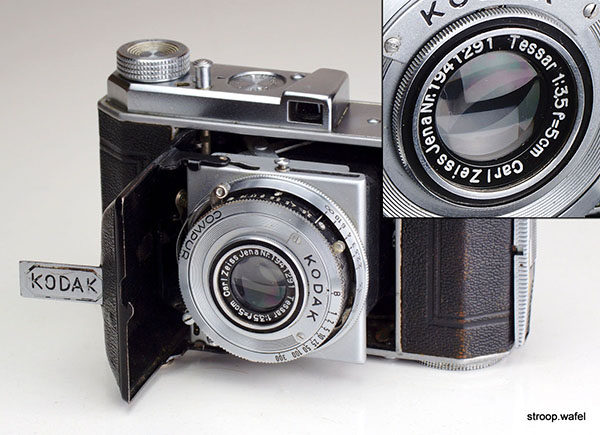
Kodak Retina 148 with Carl Zeiss Jena Tessar 50mm f/3.5 lens. Tessars are not often found on Retinas, it was estimated by the Historical Society for Retina Cameras that only about 5,000 out of more than 200,000 prewar Retinas had such a lens. The Tessars were considered premium lenses and demanded a ca. 10% markup relative to the standard Xenar. They could be found on nearly all pre-war Retina viewfinder models, except that on the Type 117 Tessars have never been reported and on Type 143 and 149 only extremely rarely.
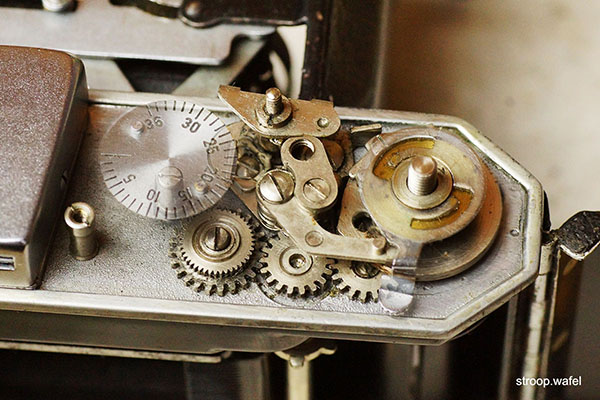
Wind mechanism of the Kodak Retina 148 with some parts made semi-transparent to show what lies underneath. The mechanism had advanced considerably since the earliest models above, even though there were only few years in-between. The wind lock would reset automatically after pushing the shutter release, which itself had moved from the shutter to the body.
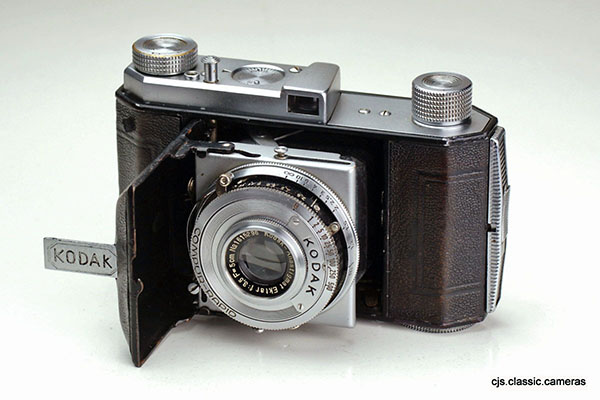
Last version of the Retina 148, characterised by its black lacquered body edges.
Kodak Retina 149
The only differences between the Type 149 and the Type 148 above were the leather inlay between the top housing and the wind knob, and the black enamel body edges (on the 148 only found on the very last version). The top housing itself was plain metal, just like the 148, but unlike the 143 versus the 141. Like the Type 148, the Type 149 was first made with a split top housing followed by a single-piece version.
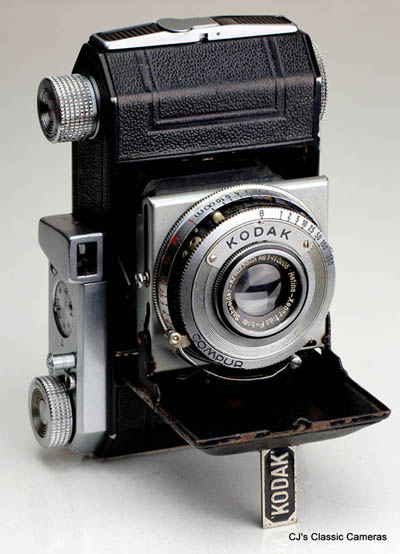
|
First version of the Kodak Retina 149 with split top housing and Schneider Xenar lens in Compur shutter. The Type 149 was only available with this particular lens-shutter combination.
|
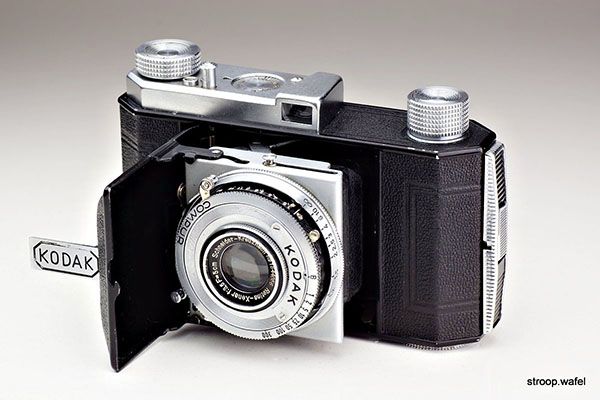
Second version of the Kodak Retina 149 with single-piece top housing. There are a few other subtle differences with the early version shown above, this late example had a black frame counter indicator instead of an open symbol, a white Kodak 'stand' instead of a black enamal one, and a straight door latch lever instead of a mushroom shaped one. As was the case for the contempary Type 148 introduced above, these changes were all not made at the same time, so quite a few slightly different models can be found.
Kodak Retina 167
Most camera production stopped during WWII, including the Kodak Retinas. However, a small number of cameras were produced until mid 1941, and even a rare new model was introduced a few months before production was halted. This Type 167 was essentially a Retinette Type 160 but with a chrome top housing. It also copied the front-cell focus system and tripplet lens from the Retinette, the only folding Kodak Retina to do so, and lacked a depth of field scale at the bottom of the camera. The assumption is that the Type 167 was mostly assembled from left-over parts.
Like the Retinette Type 160, the Retina Type 167 was available with two different shutters-lens combinations, a Compur with f/3.5 lens or a K-4-S by Gauthier (better known for their Prontor and Vario shutters) with f/4.5 lens.
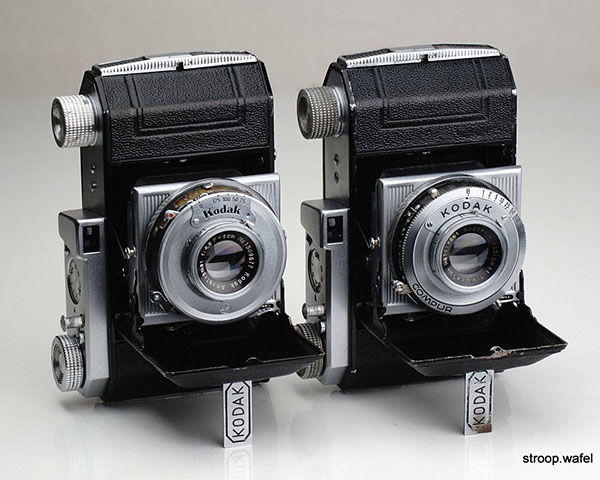
Two Kodak Retina 167, one with Compur (right) and one with K-4-S shutter (left).The version with the Compur shutter had a slightly faster f/3.5 lens than the f/4.5 on the other example.
The latest published production estimate of the Type 167 by the HSRC in 2016 was about 3,600, compared to about 17,000-40,000 for all other viewfinder models.
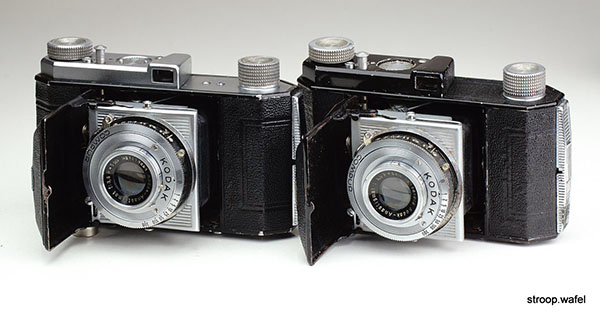
Comparison between the Kodak Retina 167 (left) and the Retinette 160 (right). Other than the colour of the top housing there was not much between them.
| 
